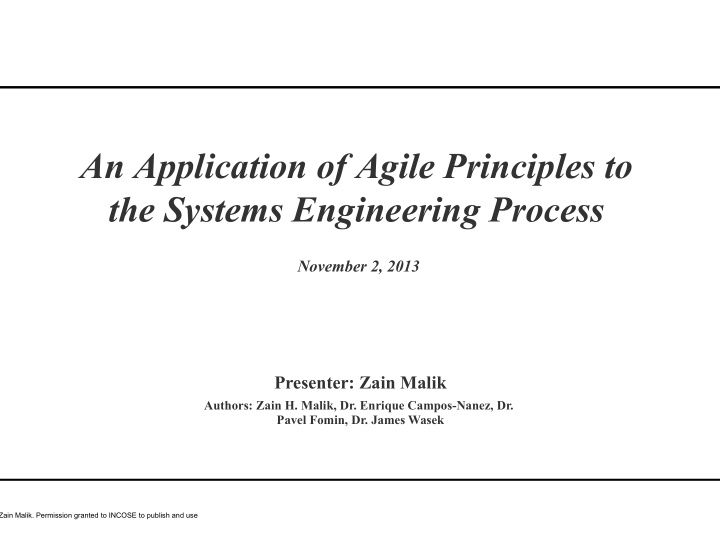



An Application of Agile Principles to the Systems Engineering Process November 2, 2013 Presenter: Zain Malik Authors: Zain H. Malik, Dr. Enrique Campos-Nanez, Dr. Pavel Fomin, Dr. James Wasek by Zain Malik. Permission granted to INCOSE to publish and use
Overview & Purpose To illustrate the benefits of applying agile principles to the Systems Engineering Process • Systems Engineering Processes and Challenges • Agile Overview • Framework for Implementing Agile Principles into Systems Engineering Process • Case Study Demonstrating Proposed Method
Systems Engineering Models V-Model Spiral Model Detailed process control Prototypes Formal deliverables Activities Gate reviews Artifacts Waterfall Model Prototyping Model Improve speed Mass production applications Detect design flaws Sequential design process Documentation
Challenges of Traditional Systems Engineering Processes Implementation of the Systems Engineering Processes presents challenges depending upon the implementation model: ! Lack of up front information ! Cost vs. benefit of formal documentation ! Responding to change ! Requirements driven ! Lack of focus on customer satisfaction
Principles behind the Agile Manifesto Customer satisfaction Early and continuous delivery Changing requirements Performance to shorter timescale Work together throughout the project Sharing information Sustainable development Reducing unnecessary work Simplicity Self-organizing teams Lessons learned s: http://agilemanifesto.org/principles.html
Traditional vs. Agile
Challenges to Agile Adoption 1. Teams had difficulty collaborating closely 8. Compliance reviews were difficult to execute within an iteration timeframe 2. Procurement practices may not support Agile projects 9. Timely adoption of new tools was difficult 3. Teams had difficulty transitioning to self- 10. Federal reporting practices do not align with directed work Agile 4. Customers did not trust iterative solutions 11. Technical environments were difficult to establish and maintain 5. Staff had difficulty committing to more timely and frequent input 12. Traditional artifact reviews do not align with Agile 6. Teams had difficulty managing iterative requirements 13. Agile guidance was not clear 7. Agencies had trouble committing staff 14. Traditional status tracking does not align with Agile 12-681 Effective Practices and Federal Challenges in Applying Agile Methods
Application of Agile Principles Hardware Engineering Hardware Hardware Systems Inte 1 2 Iteration Iteration System 1 2 Systems Iteration Iterati Concept 3 (Function A) Iterati Iteration 1 Iteration 2 Iteration 3 tomer Spec Function Function Function Systems Customer Systems A B C Concept High-level Concept System (Function B) Requirements (Function D) Function Iterati D r Inquiry / Software Engineering t Vision Systems Concept (Function C) Systems Engineering FINAL FI L P Fale, Z. Malik, Agile Principles to SE in the Commercial Environment (2013)
Agile Application Team Structure Small Cohesive team Sub-system leads Permission to make quick decisions Access to sponsor Flattened organization Ability to bring in experts Program manager reports directly to customer in Traditional Team Structure charge of program Program deputies co-located Modified Team Structure
Framework for Agile Application Utilization Stage INCO Concept Stage Development Stage Production Stage Retirement Support Stage Proc Operations & Planning Requirements, Design, Development, Integration & Test Disposal Maintenance New Requirements / Modification Requirements Product Backlog based on priority Design Development Test Sprint Backlog Review Sprint Release 1 Release 2 Release M Sprint 1 Sprint 2 Sprint N Sprint 1 Sprint 2 Sprint N Sprint 1 Sprint 2 Sprint N
Human Portable Radiation Detection System Case Study A Department of Homeland Security program Developed for Transportation Security Administration, Coast Guard, and Customs and Border Protection Developed for secondary screening Demonstrates the application of agile systems engineering for a mixed hardware and software project Design and develop a fully functional radiation detection system
HPRDS Team Structure Small Cohesive team Sub-system leads Program Permission to make quick decisions Sponsor Manager Access to sponsor Lead Systems Part-time SME Flattened organization Engineer Support Ability to bring in experts Nuclear Vendor program manager reported directly to Software Hardware Detection Lead Lead Module Lead the head of the program Nuclear Software Hardware Detection Engineers Engineers Engineers
HPRDS Process M 1 M 2 M 3 M 4 M 5 M 6 M 7 M 8 M 9 M 10 M 11 M 12 M 13 M 14 M 15 M 16 M R1 R2 R3 System SubSys 1 SubSys 2 SubSys 3 Process flow made it possible to meet cost and schedule evelopment was performed concurrently Release X Sprint Integrate sed the concept of build a little, test a little and learn a lot Test Develop Design Deliver ocused on meeting the needs of the customer Test Review Review Minimized documentation
HPRDS Product Concepts oncepts: TODAY Concept 3 Concept 4 Concept 5 1 and 2
Application & Lessons Learned Applying Agile Principles to the systems engineering lifecycle process ! Small teams with direct link to sponsor ! Give authority to make decisions ! Allow outside help as needed ! Co-locate leaders ! Use interactive design reviews ! Tailor out irrelevant processes ! Test and analyze as fast as possible
Questions? ontact Information: Zain H. Malik zmalik4@gmail.com
Recommend
More recommend